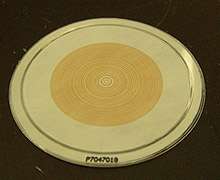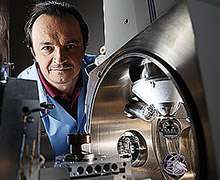A brown carbon sample prepared at EMSL.
If you've ever flown into a major metropolitan area and noticed haze hovering over the city, then you've seen brown carbon aerosols. While most people are familiar with the visual impact of brown carbon, scientists are learning more about the formation of brown-colored aerosols and how they influence climate.
"Brown carbon aerosols are an important environmental issue, and their impact on the atmospheric warming is not well understood," says Alex Laskin, an EMSL senior research scientist. "We've just started to understand what brown carbon aerosol are, how they can be formed and in what amounts. Given the complexity, it will take years of research to provide knowledge on this broad spectrum of compounds, their chemistry and their impact on the environment."
In partnership with University of California, Irvine, researchers at EMSL have been studying different aspects of the chemical composition, formation and atmospheric evolution of brown carbon aerosols for several years. The Department of Energy's Office of Biological and Environmental Research Atmospheric Systems Research Program funded the EMSL/UC-Irvine research. UC-Irvine was also supported by the National Science Foundation. EMSL, a BER national scientific user facility, is located at Pacific Northwest National Laboratory in Richland, Wash.
"During the past three years we've made significant discoveries that have triggered the next level of understanding about brown carbon aerosols," says Sergey Nizkorodov, professor of chemistry at UC-Irvine and EMSL collaborator. "Through multiple projects we've explored an area that was barely touched by the research community."
The scientists at PNNL's Atmospheric Measurements Laboratory, part of the Atmospheric Sciences and Global Change Division, have also been studying brown carbon aerosols for several years.
Research groups at UC-Irvine and AML synthesize brown carbon aerosols in environmental chambers. These facilities mimic what is happening in the atmosphere, but under controlled conditions, to produce a variety of aerosols, including those with brown carbon.
A recently started joint project between EMSL and ASGC combines the knowledge and expertise of these groups into a creative team with a goal of adding brown carbon aerosol data into climate models. The study is intended to develop capabilities that will support BER's mission to advance the understanding of Earth's biogeochemical systems in order to improve climate prediction.
"We're studying brown carbon because it's climatically relevant and not well characterized in climate models," says John Shilling, an AML scientist and co-principal investigator on the joint project. "We know brown carbon can have an impact on climate. It can change the Earth's energy balance and that will affect how climate responds to changes in air emissions."
The joint research project will study species of brown carbon formed in the atmosphere from reactions of gases that condense to form aerosol particles. Specifically, researchers hope to identify chemical reactions that cause particles to turn brown, either when they are formed or as they age in the atmosphere.
The joint project identified the types of research where EMSL's expertise, particularly in molecular-scale characterization, could be used to solve problems important for global climate. The project also takes advantage of PNNL expertise in molecular modeling, atmospheric aerosol chemistry and climate modeling. In addition to Shilling and Alex Laskin, the other co-principal investigators on the joint project are PNNL scientists Shawn Kathmann, Rahul Zaveri, Phil Rasch and Julia Laskin.
"Brown carbon is one area where we really need an integrated approach across disciplines to solve some of these large-scale problems in climate change," says Shilling. "It's the type of problem national labs and user facilities should be solving. It would be difficult for a single principal investigator working alone to tackle such a big problem."
The Properties of Brown Carbon
Scientist John Shilling stands in the Aerosol Test Chamber located in the Atmospheric Measurements Laboratory at Pacific Northwest National Laboratory. The chamber is used to study the aerosol lifecycle, and the data derived from experiments using the chamber will be used for model validation and directly incorporated into climate models.
According to Alex Laskin, "To accommodate this complex world of brown carbon, more laboratory and field studies are needed to describe this material's chemistry and optical properties and to understand the fundamental relationship between composition and optical properties."
The EMSL/UC-Irvine team has aged aerosols in the lab so they turn brown, and they quantified the optical properties of the browning effect and have a better understanding of the chemistry behind the color transformation.
A major challenge the EMSL/UC-Irvine team faced was identifying chromophores, specific molecules responsible for color, in aerosols during transformation from white to brown. The team needed a sensitive technique that allows detection of individual aerosol species that may exhibit strong light absorption properties.
"Conventional analysis didn't help us very much, because changes in the chemical composition are really, really minor," says Alex Laskin. "It turns out changes are hardly detectable by many traditional approaches. It's the presence of very minor compounds that make this material brown. It's really a task of finding a needle in the haystack."
The sensitive technique that finally allowed the EMSL/UC-Irvine team to detect small changes in chemical composition was EMSL's newly developed method of nanospray desorption electrospray ionization, or nanoDESI, in conjunction with high-resolution mass spectrometry.
"Brown carbon research was one of the first applications of the nanoDESI setup to a scientific problem, and it gave us really unique and unparalleled results," says Alex Laskin. "It was the technique that gave us clear answers to what is happening within brown carbon aerosols."
Nizkorodov agrees, adding "nanoDESI has proven to be a powerful analytical technique for the study of brown carbon aerosols. It has helped us move to that next level of understanding."
Based on numerous laboratory and field studies, the EMSL/UC-Irvine team has determined brown carbon aerosols are complex systems containing thousands of various organic molecules. The formation of brown carbon materials strongly depends on the aerosol composition – one type of aerosol may show browning but a nearly identical aerosol may not. The team also discovered that incorporation of nitrogen into the organic material contributes to the formation of certain brown carbon aerosol species.
Experiments and Modeling
Scientist Alex Laskin with EMSL’s field-emission emission environmental scanning electron microscope he uses to examine aerosols and other samples.
A PNNL Laboratory Directed Research and Development project, the ultimate goal of the EMSL and ASGC effort is to include detailed brown carbon aerosol characterization data in a form atmospheric modelers can use in predicting climate change.
"Our focus is on fundamental chemistry – the molecular-level understanding of brown carbon aerosols," says Alex Laskin. "The scope of the project is to make sense out of molecular-level chemistry and transfer that knowledge to climate models."
The joint project is part of a much loftier goal – to ultimately understand exactly how brown carbon (at all times, in all places and from all sources) affects climate, according to Shilling. The joint project continues the search for the chromophores and chemical processes and mechanisms involved in the browning of carbon aerosols. Critical to this project is EMSL's expertise in molecular-level characterization of aerosol mixtures.
"There are thousands and thousands of compounds in these aerosol particles, and we're looking for the ones that are specifically making the material brown," says Shilling. "Research efforts of Julia and Alex Laskin finally made it possible, but it's extremely difficult and extremely rare – only a few people in the world can do it."
To date, the scientists have identified a series of reaction conditions that produce brown carbon and have made some preliminary measurements of the optical properties of brown carbon. The next step is to produce samples for advanced molecular-level analysis. They will partner with Alex Laskin in using EMSL instrumentation, including nanoDESI in conjunction with high-resolution mass spectrometry and chromatography, to analyze aerosol samples with strong brown carbon capacity. As a result, they'll identify specific molecules out of the many thousands in the sample that are absorbing the light and causing the material to be brown.
The other team members have been developing the necessary computer codes and analyses, including molecular- and process-scale modeling, so that the data from EMSL's analysis can be added into a global climate model. The model should then be able to predict the climate forcing— the excess solar power retained at the Earth's surface—associated with brown carbon aerosols. Climate forcing is a metric commonly used by climate scientists that is directly related to Earth's temperature changes.
"We've measured the optical properties and we know brown aerosols will form under a broad range of conditions," says Shilling. "What we need to learn now is what effects certain brown aerosols have on the radiation balance, and how much they will change the Earth's temperature. Our ultimate goal is to determine the impact brown carbon aerosols have on climate."
What are brown carbon aerosols?
Brown carbon aerosols are non-graphitic organic materials that are brown or yellowish in color. They come from different sources, including the burning of biomass, industrial emissions, combustion of fossil fuels and automobile exhaust. Brown carbon aerosols can also be formed in the atmosphere from reactions of biogenic organic gases, given off naturally by trees and other organisms, that condense to form aerosol particles.
Researchers classify organic materials in the atmosphere by their ability to absorb or scatter sunlight. The scattering of sunlight has a cooling affect overall on the climate, while the absorption of sunlight heats the air. Carbon rich materials in the atmosphere range between predominantly scattering and strongly absorbing. The chemical and optical properties of the two extremes of the absorbing materials are known and relatively well studied. The compounds between the two extremes are brown carbon aerosols. Brown carbon aerosols are made of thousands of different complex compounds, and because of this complexity they present a significant challenge to the investigators.
Provided by Environmental Molecular Sciences Laboratory


























